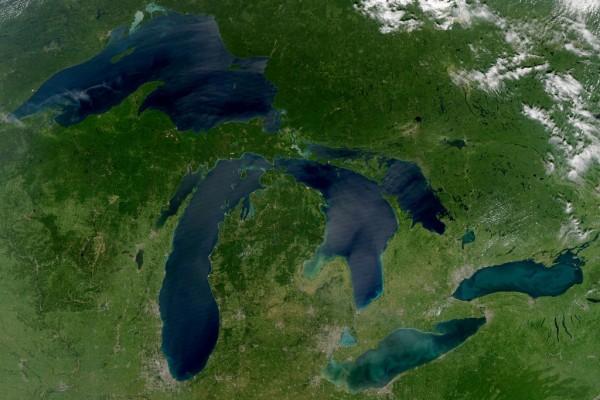 The Laurentian Great Lakes are pictured in this August 2010 NASA photo.
The Laurentian Great Lakes are pictured in this August 2010 NASA photo.
The Great Lakes could be in hot water if the quality of the research and partnerships are not improved, warns a University of Windsor professor.
“Fresh water is arguably the most important issue for the world going forward to support the planet,” said University of Windsor professor Aaron Fisk, the Tier 1 Canada Research Chair in Changing Great Lakes Ecosystems. “But the amount of resources that are dedicated to the Great Lakes from the U.S. and Canada is only a fraction of what is funded for the oceans.”
Researchers from Canada and the United States met for a workshop at Michigan State University in September 2014 and identified five scientific priorities for Great Lakes Research: climate, ecosystem processes, biophysical scale, stressors, and value to humans. Those findings were published in June 2017 by Limnology and Oceanography, a leading journal in this field.
Dr. Fisk, a professor at the Great Lakes Institute for Environmental Research and department of earth and environmental sciences, and his colleagues continue to meet regularly to review progress on each priority.
To better understand climate, Fisk said there needs to be more dedicated instrumentation, collaboration with other researchers to create comprehensive data sets and year-round research.
“This will help us understand how the Great Lakes influence climate and what the changing climate is doing to the Great Lakes,” Fisk said.
He said there currently exists a sparse buoy network that collects surface data and that there are a few research sites within the Great Lakes, but nothing close to the scale found in oceans. Without a backbone of sustained observations, Fisk said the ability to understand the climate of the Great Lakes is hindered.
“Each lake has its own unique ecosystem and characteristics,” Fisk said, touching on the second challenge of ecosystem processes. “There are issues for all of the Great Lakes, and so our priorities follow where the greatest stresses have been.”
Fisk said a lot of the research to date has focused on pollution, leading to more research on Lake Erie, Lake Michigan and Lake Ontario. The group of researchers suggested a site-based, long-term approach to ecosystem dynamics to assist in better understanding of fast-changing variables.
Another element that makes the Great Lakes such a valuable research location is their size, Fisk said.
The Great Lakes are characterized by 16,000 kilometres of shoreline, the U.S. portion of which exceeds the U.S. coasts of the Pacific and Atlantic oceans combined. The lakes cover about one million square kilometres, the largest connected surface area of any unfrozen fresh surface water in the world.
“Having a better understanding of the Great Lakes will help us to understand oceans and smaller aquatic systems better,” Fisk said, adding that the lakes contain many of the biophysical processes of small lakes and large bodies of water, providing a continuum of ecosystem sizes.
He said an example of this would be studying fish movement.
“Understanding fish movements in a confined system gives us better coverage and more specific data,” Fisk said. “This will inform us about how we do that research and what we find in the oceans.”
More than 32 per cent of Canada’s population and 10 per cent of the U.S.’s population live in the Great Lakes basin, equalling about 40 million people. The impact of that concentrated human population has degraded the Great Lakes’ recreational, economic and spiritual value.
“There are a lot of interacting stressors in the Great Lakes like invasive aquatic species, climate change, nutrients and even industrial chemicals,” Fisk said. “Understanding how these stressors interact together instead of studying them individually is really important.”
The final challenge identified by the researchers is understanding the Great Lakes’ value to humans. According to the Council of the Great Lakes Region, the economic output of the Great Lakes basin ranks ahead of Germany, France, Brazil and the United Kingdom. With an economic output estimated at $7.3 trillion, the basin would rank as the third-largest economy in the world if it were its own country.
“The value of the Great Lakes is easy to quantify in some ways, but there’s a lot of other things going on that we haven’t quantified,” Fisk said, pointing to the personal consumption of fish from the Detroit River. “It’s an important challenge — quantifying the Great Lakes better — to help better understand how our behaviour impacts those and what we take from the Great Lakes.”
Fisk said he hopes the takeaway from the paper is increased resources and funding committed to Great Lakes research.
“Canada is putting a lot of money into oceans, but they need to put more into freshwater and particularly the Great Lakes,” he said.
In the Arctic, researchers have programs like the Polar Continental Shelf Program available to them where they are provided with charter air transportation to and from remote field camps, field equipment on loan, fuel, meals, accommodation and working space.
Fisk said there’s comparably very little available for research on the Great Lakes, although it poses logistics issues similar to working in the Arctic or on oceans.
“I would love to see opportunities for academics to be able to apply to a program that’s specifically related to the Great Lakes,” he said. “Both countries need to up their funding for the Great Lakes, and it’s important for Canada to step up and be a better, more equal partner.”
Fisk said that despite the comparatively limited resources for the Great Lakes, the research community is coming forth with a voice which will help them move forward to restore the invaluable resource.


 Friends and colleagues of the late Dorey (D.J.) Lafreniere will dedicate a campus bench in her memory at 1 p.m. Monday, July 24.
Friends and colleagues of the late Dorey (D.J.) Lafreniere will dedicate a campus bench in her memory at 1 p.m. Monday, July 24.
